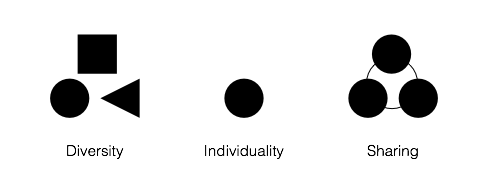In recent years the brainstorming technique is being challenged from multiple sides (Forget Brainstorming, The rise of the new Groupthink). Between the latest articles about it I found this very complete and interesting one by Jonah Lehrer in The New Yorker that after an introduction on brainstorming throws the first hit:
Brainstorming seems like an ideal technique, a feel-good way to boost productivity. But there is a problem with brainstorming. It doesn’t work.
The brainstorming was formalized by Alex Osborn around 1940s in the book “Your Creative Power” and in summary builds on three key requirements:
- Get a group of people together
- Defer judgement
- Go for quantity
Unfortunately, these three pillars were all verified over the years and were proven false:
Research shows unequivocally that brainstorming groups produce fewer and poorer quality ideas than the same number of individuals working alone. Yet firms continue to use brainstorming as a technique for generating ideas.
— Furnham A. (2000) The brainstorming myth
Debate instructions were superior to traditional brainstorming instructions. Further, these findings hold across both cultures.
— Nemeth C. (2004) The liberating role of conflict in group creativity (PDF)
The summary is that following the brainstorming rules fails in all the points:
- Individuals alone produce better ideas
- Criticism create more, better and easily reminded ideas
- Individuals alone produce more ideas
Seems that the concept of brainstorming is wrong. Or is it?
The fact is that group brainstorming is recommended solely as a supplement to individual ideation.
— Osborn A. (1952) Applied Imagination
Yes, it’s a quote from the same Osborn that formalized brainstorming. So, it seems that even at its creation, the brainstorming technique was something valuable only as a catalyst for individual work that was already done. We can clearly understand then that the problem is that the “brainstorming” product is very easily communicable and shareable, it’s a good social object and meme, and as such it was naturally disconnected from its whole process and used as it was intended.
However, even if we understand that the brainstorming technique requires a bigger process and strong individual component, there’s one very practical problem that exist in almost every company out there: if you invite people in brainstorming session almost nobody will come prepared. You’ll get answers like “I didn’t have time”. And so the brainstorming will then run without any preparation.
The road to brainstorming 2.0
Today we can then create a new “brainstorming 2.0 package”, building upon the original idea, the researches done, the contribution of a lot of experienced people from the field and of course, my own experience.
The key elements are:
- Diversity
- Individuality
- Sharing
Diversity the selection of the team is very important. In any good brainstorming group is important to avoid putting together only people that know each other very well because they will have already a common culture and grounding. The best results are instead obtained when you are able to mix external, new and different ideas coming from different people.
In the research “Collaboration and Creativity: The Small World Problem” (PDF), Brian Uzzi and his colleagues choose to analyze one environment where people were required to be creative as a team: Broadway musicals. Nobody could do a musical alone. The result was very interesting: the best musicals were the ones coming from a mixed team of people that collaborated together multiple times and some new elements that added diversity. In other terms “The best Broadway shows were produced by networks with an intermediate level of social intimacy”.
Individuality is important because it avoids the formation of groupthink that might just push forward an idea or a group of ideas. It’s important to give time to people to come up themselves with working solutions, to really face the problem think about it and try to solve it.
This is critical for many reasons:
- it forces the person to think of a solution by themselves and as such avoid just being lazy and build upon other’s ideas
- it avoids the formation of groupthink
- if allows shy people to have a structured way to propose their ideas
Sharing is basically the original brainstorming technique but without the limit of deferred judgement, because the ideas are already prepared by each individual. Since the ideas now are formed people can meet and share them in order to criticise them openly, improve them and combine them. The result will be a process that will generate more idea and combine them to create better ones.
Boosted Brainstorming
Given the assumptions above we are then able to define a new king of brainstorming that we can call Boosted Brainstorming since it’s initiated by a first step of individual generation of ideas. Such brainstorming can be split in 4 parts.
- Explanation: the problem to be discussed is presented to the group in neutral terms, without suggesting any idea or solution. The facilitator should expose the question in an engaging way, but as dryly as possible in order to not give ideas, hints or keywords. This part should last about 5 minutes and will give all the key elements to evaluate the problem.
- Generation: each person is given then 10 minutes where they need to work alone without talking or interacting with each other. After explaining this part of the work and before starting the facilitator should ask if there are questions, since it’s likely that someone wasn’t prepared to do this alone. The facilitator should also acknowledge that some people, more social in nature, in this phase could feel stressed by the forced individualism of the task. It’s important here for the facilitator to catch any question or discussion raised and help these people to feel more comfortable.
- Gathering: the facilitator stars this phase by asking every person in turn to present all the ideas to prime the discussion and after that they allows the people to confront, challenge combine and discuss the ideas presented. This phase is the longest one, taking about 40 minutes.
- Summary: the facilitator will close the discussion by picking up about one to three core ideas that everyone agrees on. This should take about 5 minutes.

The four phases can be remembered with the acronym EGGS. Notice that the points 2 and 3, the two “G”, can be repeated multiple times by doing different kinds of exercises or digging into different details of the problem, and their length can be adapted for different needs. The timings given are for an average length of one hour.
This technique isn’t new by itself, it’s just a generalization of some practices already existing. It’s similar to the open-explore-close sequence from the book Gamestorming and also it’s the foundation of Design by Example. Being a generalization it’s an excellent foundation block to build your own approach, or just simply apply it as-is in your next brainstorming.

